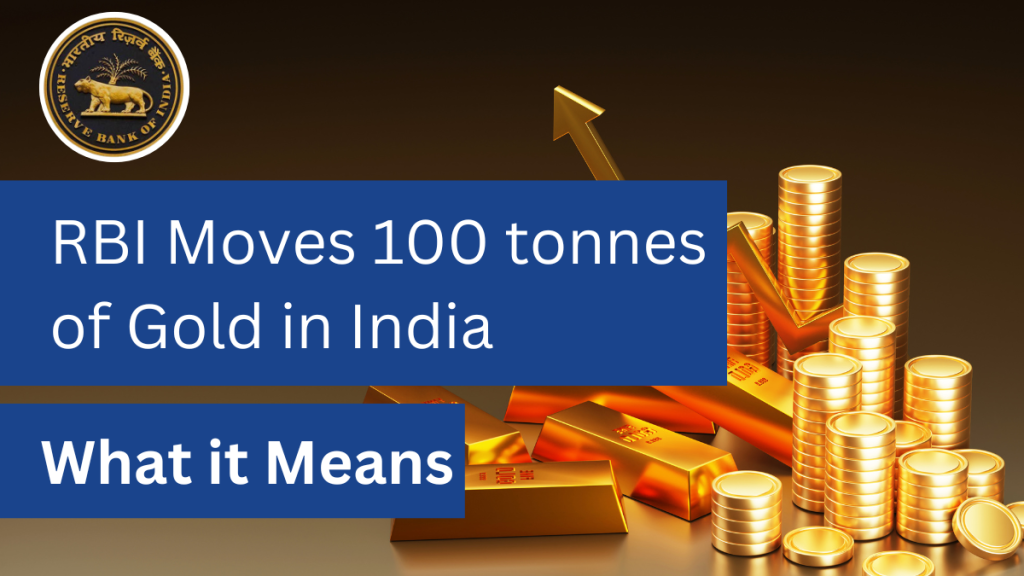Recently, the Reserve Bank of India (RBI) processed more than a hundred tonnes of gold shipped from the United Kingdom returned to India. This is an alternative giant event and represents the primary time since 1991 this massive gold was repatriated. The decision to return this gold is a clear indication that there is an increased confidence in India’s monetary stability and growth.
Historically, 1991 was a tumultuous period for India, with more severe balance of payments problems that forced the country to pledge its gold reserves to boost the monetary policy while the present scenario is in sharp contrast to then, and shows the tremendous progress India has made in its economic journey. This unprecedented move does more than just hope to save storage fees paid to the Bank of England. By having a larger share of domestic reserves, it also hopes to reduce future geographical or political risks.
In this blog, we will explore the implications of this particular event. Thereafter, we will take a closer look at the historical context of this phenomenon in relation to Indian gold reserves. Not only that, through this blog you will also understand the guidelines behind this move And most importantly, we will know the importance of this decision and how it will affect India’s future economic policy If you understand all these aspects clearly completed, you will be able to clearly understand the great implications of this decision on India’s economic stability and global economic conditions

The Historical Context of the RBI’s Decision
To understand the overall significance of the current move by the Reserve Bank of India (RBI), it is quite necessary to understand the historical context of the events of 1991 which led to this decision. During this period, India was faced with severe economic situation that it called for some urgent steps for financial stability. During the time period of July 1991, the RBI made the rather startling decision to pledge a rather significant sum of the nation’s gold reserves – close to 46.91 tonnes with the Bank of England and the Bank of Japan for a sum of 400 million US dollars which was needed to stabilize the Indian economy.
This move seemed to echo throughout the nation. It was a rather stark reminder of the extreme financial distress that India was facing. It also indicated the challenges India faced on the economic front. India’s decision in 1991 to pledge its gold reserves caused shock and criticism nationwide. It highlighted the country’s serious economic problems and the need for urgent reforms. The move had a lasting impact on Indians, demonstrating the urgency of addressing the underlying causes of the crisis and ensuring future economic stability.
Factors Behind RBI’s Decision to Move the Gold Now
The recent shifting of gold from UK to India can be understood through a number of reasons: these include cost saving, concerns regarding logistics and security, diversification of storage locations and building the confidence in Indian economy. Now let’s look at why this happened now.
- Cost Savings: By transferring much of its gold assets from other countries to India, the RBI not only saves money on holding costs but also ensures better control and safety over its possessions. This is a prudent move for the central bank to make as it seeks to maximize the use of its resources while reducing its dependence upon external storage facilities. Better still, when gold is repatriated back in their country it makes India more economically independent and assures that they are able to safeguard their precious national wealth within domestic frontiers.
- Logistical and Security Reasons: Carrying out local transfers has an effect of making it easier in terms of control and security besides facilitating planning. Keeping its gold reserves concentrated in India allows the RBI to manage effectively both storage and transportation logistics thereby mitigating risks connected with reliance on external sources. Moreover, less dependent on foreign storehouses strengthens Indian grip over assets thus enhancing national sovereignty
- Storage Diversification: Having gold reserves in different places is a smart way for RBI to control any chances of risks. By spreading its assets across different locations, the Central Bank can put an end to any kind of vulnerability. It can reduce any kind of political or economic uncertainties that can occur otherwise. This clever strategy will go a long way in ensuring that India’s gold reserves are resilient. It also makes sure that changing location does not compromise the integrity of the entire reserve. So by adopting this approach , RBI is strengthening the security and balance of its precious metals.
- Economic confidence: The RBI’s decision to once again ship a significant amount of gold to India is a strong sign of confidence in the financial stability of the US. It shows that the relevant financial institution has strong faith in our ability to protect valuables within our borders. Not the easiest, this flow shows confidence in the resilience of the Indian economy, but also underlines the RBI’s commitment to responsible financial control and risk minimization. By repatriating India’s gold reserves, India is sending a clear message to both its neighbors and stakeholders around the world that we are committed to protecting our wealth and ensuring long-term financial prosperity.
The Current Situation Regarding RBI and India’s Gold Reserves
As of March 31, 2024, the Reserve Bank of India (RBI) held a whopping 822.10 tonnes of gold, up from 794.63 tonnes in the previous 12 months. About half of this gold was saved overseas, mainly with the Bank of England and the Bank of International Settlements. But that’s not all! A significant element, specifically around 1 – 0.33 to be exact, has turned into maintained right here in our own USA.
Now nearly a 100 tonnes of gold have been moved back to India. One rather wecome benefit of this move is that it will help increase our home holdings. One advantage of this circulation is its ease. The price of gold relative to the overall forex of India has long since increased from 7.75% in December 2023 to 8.7% by the end of April 2024. This is an alternative smart move. This is really due to the fact that it has helped reduce some unwanted overseas currency volatility. Additionally, it helped stop any other political landmines that would emerge.
Global Context: RBI and Gold Reserves
According to a report prepared by the World Gold Council, a number of global Central Banks hold about 17% of all the gold ever mined. This means there were gold reserves totaling 36,699 metric tons by the end of 2023, which might have risen from then. Central banks around the world have been growing their gold reserves in current years, often as a hedge against financial instability and tensions in international relations.
The Indian move is part of a wider trend. This means that a lot of Central Banks have begun to diversify their reserves to include more gold. This is seen as a rather wise strategy to defend against currency devaluation and ensure some economic stability.
The Logistics of Moving 100 Tonnes of Gold by RBI
Moving a significant amount of gold requires careful planning and execution. For context, one hundred tons of gold is something like one-fourth of India’s total gold reserves as of the end of March. The system required close coordination between the RBI, the Ministry of Finance and various departments of the authorities, including the nearby Govt.
A specialized aircraft was used to transport the gold, which is monitored by complex security elements. In addition, the RBI has obtained duty exemptions to facilitate the import of this gold, with the government forgoing revenue from what is considered a sovereign asset. However, the integrated Goods and Services Tax (GST), levied on imports and shared with states, has changed to already exempt.
Economic and Strategic Implications of RBI’s Move
There are some economic and strategic implications that you need to be aware of regarding the RBI’s decision to move 100 tonne of Gold. Let’s take a look at some of them:
- Increase in Domestic Reserves: Increasing the amount of gold held domestically increases the financial balance of the United States and provides a buffer against economic shocks.
- Reduce in Storage Costs: By reducing reliance on overseas garages, the RBI can save on costs associated with storing gold overseas.
- Economic Confidence: Circulating indicators of strong monetary confidence and the shift away from past disaster-forced decisions. It reflects India’s growing monetary position and potential to properly control its financial assets.
- Policy Considerations: In an increasingly uncertain global environment, regional gold containment can offer protection in opposition to geopolitical capability disruptions.
RBI’s Strategic Diversification of Reserves
RBI’s latest gold purchases are part of a broader approach to diversify its reserves. In the first sector of 2024, the RBI alone offered 19 tonnes of gold, surpassing the 16 tonnes sold in the entire year 2023. This multiplied interest in gold is indicative of the respective bank’s method of hedging against currency risks and global financial uncertainty..
Gold is often considered a safe-haven asset and its importance has been highlighted in cases of financial turmoil. By growing its gold reserves, the RBI is not the simplest way of diversifying its portfolio, but rather of strengthening its economic function.
RBI Gold: A Symbol of Economic Strength
Gold has a huge emotional and economic value in India. The latest transfer can be seen as a picture of India’s financial strength and resilience. It’s a stark assessment of the days in 1991 when the country needed to pledge its gold to avert a financial crisis.
The move further highlights the evolution of India’s financial guidelines and its journey towards becoming an extremely self-sustaining and strong financial system. It shows RBI’s proactive method in managing the country’s reserves and ensuring financial stability.
RBI Future: More Gold to Come?
Reports advocate that the RBI can also flow extra gold to India within the coming months. This should further improve the us of a’s home reserves and decrease reliance on overseas storage. It also aligns with the RBI’s method of periodically reviewing and adjusting its garage practices to ensure highest quality management of its property.
Prepping for RBI Exams with ixamBee
ixamBee provides extensive online coaching and other resources for various recruitments and vacancies that the Reserve Bank of India (RBI) offers. This includes roles like RBI Grade A Rajbhasha, RBI Grade B, RBI Assistant, RBI Office Attendant, RBI Grade B DEPR, RBI Grade B Legal, and RBI Non CSG to name just a few for those aspiring an RBI career. These courses prepare students for promising career paths and help them to contribute quite extensively to the RBI’s mission of shaping a new and progressive India.
ixamBee offers a lot of resources tailored to empower aspirants with the skills that they need to get lucrative positions within the Reserve Bank of India. Notably, ixamBee offers its aspirants with Mock Tests. These tests will help aspirants to simulate exam conditions and analyze their performance perfectly. These mock tests have been designed carefully to resemble the actual RBI exam pattern. It offers some careful insights into the the different kinds of questions, time management, and overall exam dynamics.
Moreover, ixamBee also offers its aspirants with Previous Year Papers, which gives insights into the previous trends of the RBI exams. Looking carefully at these past papers will help candidates to understand more about the exam. It will help them to fine-tune their preparation according to this. Besides this, the Online Courses provided by ixamBee have been created by experts. They include the complete syllabus and offer features like study notes and video lessons to help aspirants. Finally, BeePedia is another resource which helps aspirants for preparing the General Awareness section.
Summing Up
The RBI’s choice to transfer more than a hundred tonnes of gold from the UK to India highlights a strategic effort to diversify and secure India’s gold reserves, reduce storage charges and demonstrate financial confidence. This flow underscores gold’s function as a hedge against currency and geopolitical risks. It signifies India’s financial resilience and strategic foresight, and marks a brand new bankruptcy in the US financial adventure rooted in strength, confidence and prudential control.
To help you prepare 50% faster for competitive exams, ixamBee provides free Mock Test Series and all the Current Affairs in English and Current Affairs in Hindi in the BeePedia capsules for GA Preparation. You can also get the latest updates for Bank PO, Bank Clerk, SSC, RBI Grade B, NABARD, and Other Government Jobs.
Also Read:
Everything to Know About the World’s Top Central Banks
Some RBI Grade B Preparation Tips for Non-Banking Backgrounds















